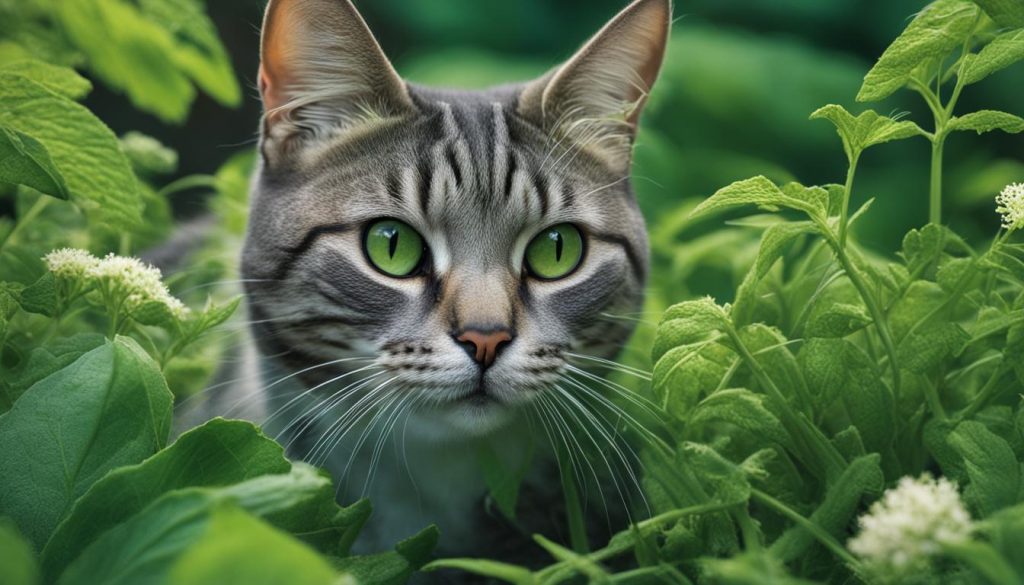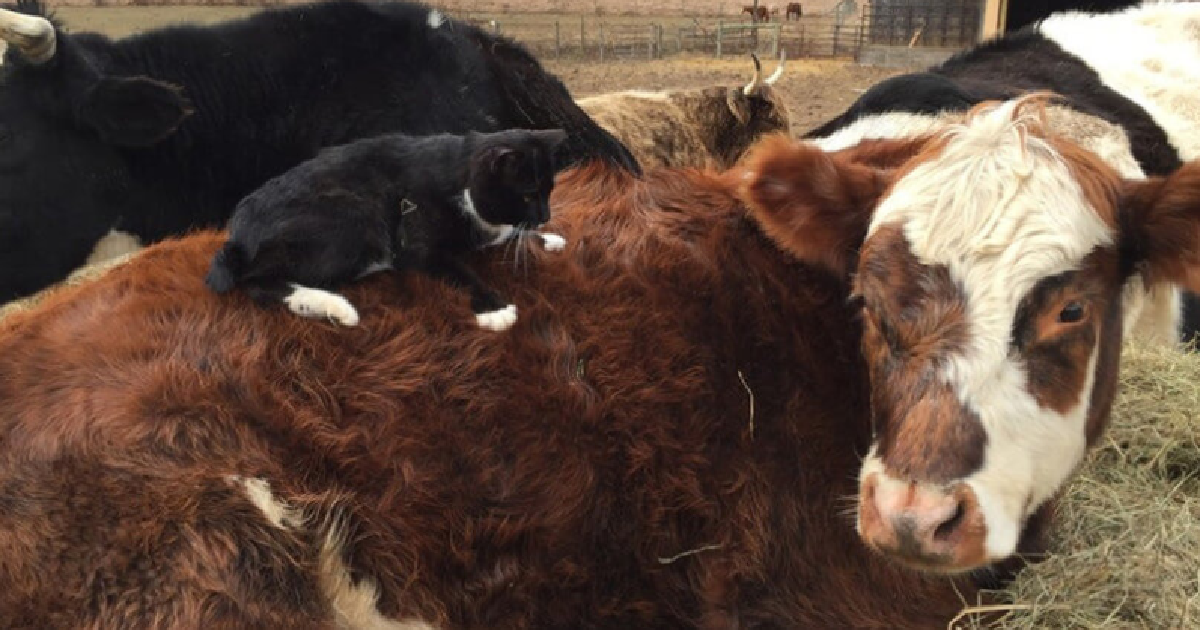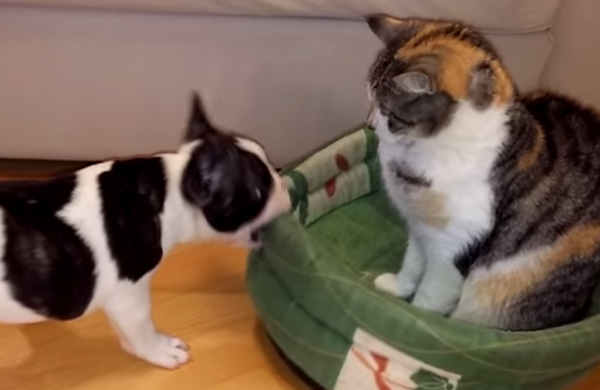As cat owners, we always want to ensure that our furry friends are happy and healthy. One common question that arises is whether cats can eat catnip. Catnip, also known as Nepeta cataria, is a herb that belongs to the mint family and contains a chemical called nepetalactone. But can cats safely consume catnip? Let’s explore the topic further and understand the effects of catnip on our feline companions.
Can Cats Eat Catnip? Yes, it’s perfectly safe.
- Catnip is generally safe for cats to consume, but it should be given in moderation to prevent nausea or vomiting.
- Catnip can have several health benefits for cats, including reducing stress, promoting relaxation, and encouraging play and activity.
- Catnip, also known as Nepeta cataria, is a herb that belongs to the mint family.
- When cats inhale catnip, it acts as a stimulant, while when ingested, it has a sedative effect.
- Approximately 50-70% of cats are responsive to catnip.
How Does Catnip Affect Cats?
Catnip can have varying effects on cats, depending on the individual. When cats encounter catnip, some may become mellow and quiet, while others may become playful and excited. In rare cases, cats may even display a slight aggression. The effects of catnip typically last for about 15 to 30 minutes, and cats may not respond to it again for a few hours. It’s important to note that not all cats are responsive to catnip, and genetic factors may play a role in determining a cat’s reaction.
Catnip is generally safe for cats and can provide several benefits for their health. The main benefits include stress reduction and relaxation. The chemical compound nepetalactone found in catnip acts as a natural stimulant for cats, which can promote mental and physical well-being. However, it’s crucial to consult with a veterinarian before introducing catnip to your cat, especially if they have any underlying health conditions.
The Connection Between Catnip and Cats’ Health
When used appropriately, catnip can be a wonderful addition to your cat’s environment. It can help reduce stress, promote relaxation, and encourage play and activity. However, it’s important to give catnip in moderation and monitor your cat’s response. Too much catnip can lead to nausea, vomiting, or diarrhea. By providing catnip as an occasional treat, you can ensure that your cat benefits from its positive effects while avoiding any potential negative consequences.
Remember, every cat is unique, so it’s essential to observe your cat’s behavior and adjust the amount of catnip accordingly. If your cat doesn’t respond to catnip or has adverse reactions, there are alternative substances such as silver vine and valerian root that can have similar effects. These alternatives provide options for cat owners to explore and find the best option for their feline companion.
Is Catnip Safe for Cats?
Many cat owners wonder if catnip is safe for their feline friends. The good news is that catnip is generally considered safe for cats to consume and interact with. Catnip is a non-toxic herb that does not pose any harm when ingested or inhaled by cats.
However, it’s important to give catnip to your cat in moderation and monitor their response. Too much catnip can lead to gastrointestinal issues such as nausea, vomiting, or diarrhea. It’s always best to start with a small amount and observe how your cat reacts before giving them more.
Monitoring Your Cat’s Response
Every cat is unique, and their reaction to catnip can vary. While some cats may become playful and excited when exposed to catnip, others may have a more mellow or relaxed response. It’s crucial to pay attention to your cat’s behavior and ensure they are not overindulging in catnip.
If your cat shows adverse effects or does not seem interested in catnip, there are alternatives available. Silver vine, valerian root, and Tatarian honeysuckle are safe and non-toxic alternatives that can produce similar effects in cats. These alternatives provide cat owners with options to explore if their cats do not respond well to catnip.
Catnip is generally safe for cats, but it’s important to give it in moderation and monitor your cat’s response. If you have any concerns or questions about using catnip with your cat, it’s always best to consult with a veterinarian for personalized advice.
Using Catnip with Cats: Do’s and Don’ts
When it comes to using catnip with cats, there are a few guidelines to follow to ensure a positive experience for both you and your feline friend.
Start with a small amount
It’s best to introduce catnip to your cat in small doses to gauge their response. Start with a pinch of dried catnip or a small sprig of fresh catnip and observe how your cat reacts. Some cats may become instantly playful, while others may take some time to warm up to the herb.
Don’t overdo it
While catnip can be an enjoyable treat for cats, it’s essential not to give them too much. Overindulging in catnip can lead to upset stomachs, vomiting, or diarrhea. It’s recommended to limit catnip sessions to a few minutes at a time and give your cat a break in between to prevent any negative side effects.
Do use catnip toys
One of the best ways to offer catnip to your cat is through catnip-infused toys. These toys are designed to release the scent of catnip, enticing your feline friend to play and engage with them. Catnip toys can provide hours of entertainment and stimulate your cat’s natural hunting instincts.
Don’t use catnip with aggressive cats
While most cats enjoy the effects of catnip, some cats may react aggressively when exposed to it. If your cat becomes agitated, overly hyperactive, or exhibits aggressive behavior after interacting with catnip, it’s best to avoid using it with them. Instead, focus on other forms of play and enrichment to keep them engaged and entertained.
By following these simple do’s and don’ts, you can ensure a safe and enjoyable experience when using catnip with your cat. Remember, every cat is unique, and their response to catnip may vary. Pay attention to your cat’s behavior and consult with a veterinarian if you have any concerns or questions about using catnip.
Catnip Alternatives for Cats
While catnip is a popular choice for many cats, not all felines respond to it. If your cat doesn’t seem interested in catnip or you’re looking for something different, there are several alternatives to consider.

Silver Vine
Silver vine, also known as Actinidia polygama, is a plant that contains chemicals similar to those found in catnip. It can elicit a response in cats that are not responsive to catnip. Many cats find silver vine appealing and enjoy playing with toys or accessories that contain this alternative.
Valerian Root
Another alternative to catnip is valerian root. It has similar effects to catnip and can help calm cats experiencing anxiety. Valerian root is available in various forms, including sprays and toys, making it easy to introduce to your feline friend.
Tatarian Honeysuckle
Tatarian honeysuckle is a non-toxic plant material that can produce similar effects to catnip in some cats. It can be used as a toy for kitties who don’t respond to catnip. Many cats find the scent of Tatarian honeysuckle stimulating and enjoyable.
Catnip and Eating Behavior
When it comes to catnip, many cat owners wonder about its impact on their feline friend’s eating behavior. Can cats eat catnip? Let’s explore this question further.
Catnip itself is non-toxic and safe for cats to consume, including the leaves. However, the effects of catnip on eating behavior are less pronounced compared to its stimulating or calming effects. Smelling catnip tends to stimulate cats and make them active, while eating catnip can have a calming effect.
Monitoring Catnip Consumption
While catnip is generally safe, it’s essential to monitor your cat to ensure they don’t consume excessive amounts. Overindulgence in catnip can lead to digestive issues such as nausea or diarrhea. So, it’s best to offer catnip in moderation, as a treat, and not as a major part of their diet.
If you’re looking to adjust your cat’s appetite, it’s always a good idea to consult with a veterinarian. They can provide appropriate recommendations based on your cat’s specific needs and health status.
In conclusion, while cats can eat catnip leaves, it’s important to offer it in moderation to prevent any digestive issues. Catnip primarily affects cats’ behavior and provides mental and physical stimulation, rather than directly influencing their eating habits. Always keep an eye on your cat’s consumption and consult with a veterinarian for personalized guidance if needed.
How Much Catnip Should You Give a Cat?
When it comes to giving catnip to your feline friend, it’s important to find the right balance. While catnip can be a delightful treat for cats and provide various benefits, moderation is key to ensure your cat’s health and well-being. So, how much catnip should you give a cat?
As with any new addition to your cat’s diet or environment, it’s best to start with a small amount of catnip and observe their reaction. Begin by giving a small pinch of catnip to see how your cat responds. Pay attention to their behavior, and if they enjoy the experience, you can continue to offer catnip as an occasional treat.
Monitoring Your Cat’s Response
Every cat is unique, and their response to catnip may vary. Some cats may become more playful and exhibit excitement, while others may become more relaxed and mellow. It’s crucial to monitor your cat’s behavior after giving them catnip to ensure they react positively and do not experience any adverse effects.
Additionally, it’s important to avoid giving catnip too frequently. Over time, cats can develop a tolerance to catnip, diminishing its effectiveness. To avoid this, it’s best to offer catnip as an occasional treat, allowing your cat to fully enjoy its effects each time.
Creating a positive environment for your cat to enjoy catnip is also essential. Consider introducing cat furniture or toys in a designated space where your cat can relax or play after consuming catnip. This will enhance their overall experience and provide a safe and enjoyable environment for them.
When it comes to catnip, less is often more. Start with a small amount, monitor your cat’s response, and provide catnip as an occasional treat. By doing so, you can ensure your cat’s health and enjoy the benefits of catnip as a delightful addition to their life.
Conclusion
After exploring the world of catnip and its effects on our feline friends, it’s clear that catnip can be a safe and enjoyable addition to your cat’s environment. Whether it’s providing a stimulating experience or promoting relaxation and play, catnip has the potential to enhance your cat’s well-being.
It’s important to remember that not all cats will have the same reaction to catnip, as some may be more responsive than others. If your cat doesn’t seem interested in catnip, don’t worry! There are alternatives available, such as silver vine, valerian root, and Tatarian honeysuckle, which can provide similar effects for cats that don’t respond to catnip.
When introducing catnip to your cat, it’s essential to do so in moderation. Start with a small amount and observe your cat’s behavior. Giving too much catnip can lead to digestive issues, so it’s important to monitor your cat’s intake. It’s also important to consult with a veterinarian if you have any concerns or questions about using catnip with your cat, especially if they have any underlying health conditions.
Overall, catnip can provide a positive experience for many cats, but it’s crucial to understand your individual cat’s needs and preferences. With the right approach and attention to your cat’s well-being, catnip can be a wonderful addition to their daily lives, providing stimulation, relaxation, and joy.
FAQ
Can cats eat catnip?
Yes, cats can eat catnip. It is a non-toxic herb that is safe for cats to consume.
How does catnip affect cats?
Catnip acts as a stimulant when inhaled, making cats excited and playful. When ingested, it has a sedative effect and can help reduce stress and promote relaxation.
Is catnip safe for cats?
Yes, catnip is generally safe for cats. However, it should be given in moderation to prevent nausea or vomiting. It is important to monitor your cat’s response to catnip.
What are the do’s and don’ts of using catnip with cats?
Do start with a small amount of catnip and monitor your cat’s response. Don’t give too much catnip, as it can cause digestive issues. Do keep catnip in a safe place and use it as a treat. Don’t use catnip if your cat reacts aggressively to it.
Are there alternatives to catnip for cats?
Yes, there are alternatives such as silver vine, valerian root, and Tatarian honeysuckle that can elicit similar effects to catnip for cats that do not respond to it.
Does catnip affect cats’ eating behavior?
Catnip tends to stimulate cats when inhaled and make them active, while ingesting catnip has a calming effect. It is generally safe for cats to eat catnip, including the leaves.
How much catnip should you give a cat?
The amount of catnip to give a cat can vary. It is best to start with a small amount and observe your cat’s behavior. Avoid giving catnip too frequently to prevent tolerance buildup.
Can cats eat catnip?
Yes, cats can eat catnip. It is a non-toxic herb that is safe for cats to consume.






